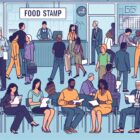Guide to SNAP Benefits for Low-Income Households

Did you know that over 40 million low-income households in the United States rely on SNAP benefits to help put food on the table?
If you’re struggling to make ends meet, this guide is here to help you navigate the world of SNAP benefits. From understanding the eligibility requirements to learning how to apply and utilize your benefits, we’ve got you covered.
Let’s dive in and make sure you’re getting the assistance you need.
Key Takeaways
- SNAP benefits are available to low-income households who meet certain eligibility requirements, including income limits, resource limits, citizenship or immigration status, and work requirements.
- The application process for SNAP benefits involves gathering necessary documents, filling out the application, submitting it, attending an interview, and receiving a decision regarding eligibility.
- SNAP benefits are distributed through an Electronic Benefit Transfer (EBT) card and can be used to purchase nutritious food.
- SNAP participants can maximize their benefits by planning meals, comparing prices, cooking at home, buying in-season produce, and utilizing community resources such as food pantries and farmer’s markets.
Eligibility Requirements
To determine if you qualify for SNAP benefits, you must meet certain eligibility requirements. These requirements are in place to ensure that the assistance is provided to those who truly need it.
Firstly, your income must be within a certain limit. Generally, households with a gross income of no more than 130% of the federal poverty level qualify. However, if a member of your household is elderly or disabled, the income limit may be slightly higher.
Secondly, your resources will be taken into consideration. Resources include things like cash, bank accounts, and vehicles. The limit for resources varies depending on your household situation. For most households, the limit is $2,250. However, if a member of your household is elderly or disabled, the limit is $3,500.
Thirdly, you must meet certain citizenship and immigration requirements. Generally, U.S. citizens and certain qualified non-citizens can qualify for SNAP benefits.
Lastly, you must also meet certain work requirements. However, exemptions are available for certain individuals, such as those who are elderly, disabled, or caring for young children.
It is important to note that these eligibility requirements may vary slightly from state to state. Therefore, it’s best to contact your local SNAP office for specific information regarding your eligibility.
Application Process
Once you have determined your eligibility for SNAP benefits, the next step is to complete the application process. Here are five important steps to help you navigate through the process smoothly:
- Gather necessary documents: Before starting the application, gather documents such as proof of identity, residency, income, and expenses. This will help ensure that you have all the information needed to complete the application accurately.
- Fill out the application: You can apply for SNAP benefits online, by mail, or in person at your local SNAP office. Provide all the required information, answer the questions honestly, and make sure to sign and date the application.
- Submit the application: After filling out the application, submit it to the appropriate SNAP office. If you apply online, you can submit the application electronically. If you prefer to apply by mail or in person, check the SNAP office’s address or location.
- Attend an interview: Once your application is received, you’ll be scheduled for an interview. The purpose of the interview is to verify the information on your application and discuss your eligibility further. Be prepared to provide additional documentation if requested.
- Receive a decision: After the interview, you’ll receive a notice informing you of the decision regarding your SNAP benefits. If approved, you’ll receive an EBT card, which is used to purchase eligible food items at authorized retailers.
Completing the SNAP application process may seem overwhelming at first, but following these steps will help ensure a smooth and successful application experience.
SNAP Benefits and Assistance
You can receive SNAP benefits and access valuable assistance through the Supplemental Nutrition Assistance Program. SNAP provides assistance to low-income households to help them purchase nutritious food. The benefits are distributed through an Electronic Benefit Transfer (EBT) card, which can be used at authorized retailers.
To determine your eligibility for SNAP benefits, you’ll need to complete an application and provide documentation such as income, expenses, and household size. The application process includes an interview, either in person or over the phone, to verify the information provided. Once approved, you’ll receive an EBT card, and the amount of benefits you receive will depend on your household’s income and expenses.
In addition to the monetary benefits, SNAP also offers assistance in finding resources and programs that can help improve your overall well-being. These resources may include nutrition education programs, job training, and referrals to other social services.
If you need assistance with your SNAP benefits or have any questions, you can contact your local SNAP office or visit their website for more information. They can provide guidance on how to use your benefits, report changes in your circumstances, and address any concerns or issues you may have.
Utilizing SNAP Benefits
Make the most of your SNAP benefits by utilizing them effectively to ensure your family’s access to nutritious food. Here are five tips to help you maximize the benefits:
- Plan your meals: Before heading to the grocery store, make a list of the items you need and plan your meals for the week. This will help you avoid buying unnecessary items and ensure that you have enough food to last throughout the week.
- Compare prices: Take the time to compare prices at different stores to get the best deals. Look for sales, use coupons, and consider buying in bulk for long-term savings. This way, you can stretch your SNAP benefits and get more value for your money.
- Cook at home: Eating out can quickly deplete your SNAP benefits. Instead, try cooking at home more often. Cooking meals from scratch can be more cost-effective and allows you to control the ingredients, making healthier choices for your family.
- Buy in-season produce: Opt for fresh fruits and vegetables that are in-season, as they tend to be more affordable. You can also consider buying frozen or canned produce, which can be just as nutritious and often more budget-friendly.
- Use community resources: Take advantage of local food pantries, farmer’s markets, and community gardens. These resources can supplement your SNAP benefits, providing you with additional access to fresh and affordable food options.
Resources for SNAP Participants
To make the most of your SNAP benefits, it’s important to be aware of the various resources available to participants. These resources can help you stretch your benefits further and provide additional support for you and your family.
One important resource is the SNAP Retailer Locator, which allows you to find stores in your area that accept SNAP benefits. This can be especially helpful if you’re new to the program or if you have recently moved to a new area.
Additionally, many states offer SNAP education and outreach programs that can provide you with information on how to make healthy food choices and budget your benefits effectively. These programs often include workshops, cooking demonstrations, and other resources to help you make the most of your benefits.
Lastly, some states also have SNAP hotlines or online portals where you can get answers to your questions, report issues, or get assistance with your benefits.
Frequently Asked Questions
Can SNAP Benefits Be Used to Purchase Non-Food Items Such as Cleaning Supplies or Toiletries?
Yes, you can use SNAP benefits to buy non-food items like cleaning supplies or toiletries. It’s a helpful way to stretch your budget and meet essential needs while receiving assistance.
Are There Any Restrictions on the Types of Foods That Can Be Purchased With SNAP Benefits?
Yes, there are restrictions on the types of foods you can buy with SNAP benefits. The program aims to provide nutritious food, so items like alcohol, tobacco, and hot prepared foods are not eligible.
Can SNAP Benefits Be Used to Purchase Hot Prepared Meals From Restaurants?
Yes, you can use SNAP benefits to purchase hot prepared meals from certain restaurants. This allows you to have access to nutritious meals even if you don’t have the means to cook at home.
If a Household’s Income Increases After They Have Been Approved for SNAP Benefits, Will Their Benefits Be Automatically Adjusted?
If your income increases after you’re approved for SNAP benefits, your benefits may not automatically adjust. It’s important to report any income changes to your local SNAP office to ensure you receive the correct benefits.
Are There Any Penalties or Consequences for Not Using All of the SNAP Benefits Allocated to a Household in a Given Month?
If you don’t use all of your SNAP benefits in a month, there are no penalties or consequences. The unused benefits will roll over to the next month and can be used then.



